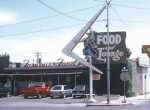City landmark resurrected

When it opened in the early 1950s, the El Rancho coffee shop and restaurant became one of the city's busiest social gathering places.
It was built in an area of Mountain Home that served as a hub of sorts for those traveling on U.S. Highway 30, which at one point stretched from Oregon to Ohio before the interstates were built.
On any given day, family and friends would gather at the El Rancho for a cup of coffee or a meal. Additions tacked on to the building over the years allowed it to host meetings, banquets, wedding receptions and other celebrations.

But after nearly half a century, the community landmark at 115 East Jackson Street was torn down in 2003 to make way for a new railroad bridge and a wider underpass on what is now the beginning stretch of Airbase Road. The memory of the coffee shop and restaurant owned at one point by Hugh Falkner and Jim McMullen started to fade.
The El Rancho name, however, continues to live on.
Lacking any fanfare to celebrate its return, the sign that once stood at the front of the famed restaurant rose again against the Mountain Home skyline on May 17.
Bearing the image of a matador holding a whip, the restored landmark stands near the corner of East Jackson between North Main and North 2nd East streets. The sign was the last in at least three different versions that stood in front of the restaurant over the years.
The matador that became synonymous with the El Rancho likely made its first appearance in a sign that stood out front before the last version made him more prominent. Made of wood, it was built in two sections -- a mirror image of one another.
To a point, restoring the sign is helping to reconnect the community to the past, according to those wanting to preserve its memory.
The story actually begins sometime before the actual building was demolished. John Hiler, whose family owns a service station just a few blocks away on North 2nd East Street, wanted to save the landmark. It was a way to help preserve a piece of the city's history.
From his perspective, Mountain Home was known for similar signs and landmarks, but there was no attempt to save them. Instead, the others were torn down and thrown in a landfill.
He didn't want to see the El Rancho sign suffer the same fate.
"I heard they were cutting it down, so I took my truck over there and picked it up," he said. "I would've salvaged the whole thing, but by then it was already partially demolished."
Hiler took one of the two pieces of the sign and gave one to the Mountain Home Historical Museum. He kept the other half at the family's service station for safe keeping.
Over the next several years, knowledge of the sign had started to fade, including the fact that Hiler had kept the other piece.
However, the legacy of the El Rancho cafe lived on.
In 2008, the city purchased the remaining section of the former restaurant property from the state. The empty field found a new purpose as a community parking lot -- a stipulation outlined in the sales agreement.
While the lot didn't have a formal name, the city council often referred to the property as the "El Rancho lot" in memory of the once-popular eatery.
Unaware that both pieces still existed, the city hoped to take the museum's half of the El Rancho sign in recent years and have it restored to its former glory by local art students. The idea was to have it mounted next to city hall.
But those plans changed after Hiler announced that he still had the other half of the sign and was willing to donate it to the city. At that point, the city hoped to put both signs on permanent display, according to Mayor Tom Rist.
Using a grant from Union Pacific, artist Doug Batchelor took both sections and restored them to like-new condition.
However, the wooden pieces were still fragile and needed something protect them from the wind and the elements. County commissioner Bud Corbus volunteered to build a metal frame to hold everything in place.
While everything was ready to go in March, those heading the restoration project had to wait for the weather to improve before the sign could receive a needed coat of weather sealant, Rist said.
With no ceremony or even a heads up, the city parks and recreation department hoisted the restored sign into its permanent location on May 17. In fact, the mayor admitted that he wasn't aware that the sign was in place until he received a call from parks and recreation director Stan Franks.
Hiler wishes people had taken more of an interest in landmarks like the El Rancho sign.
"Most people think that it's just a sign," he said. "But after 20 or so years, it becomes something unique."
